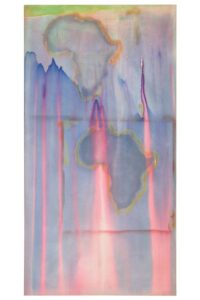
Frank Bowling Barticaborn I 1967 Lowinger Family Collection © Frank Bowling. All Rights Reserved, DACS 2019

At 24, Bowling wanted to “paint his people”. However painting people was not his forte. Whilst the curves of the room in “Mirror” 1966 are superb in their perspective and placing, the Baconesque figures descending the spiral staircase are poorly drawn.
He copies a photograph of a Mary Quant attired model in “Cover Girl”, but the poor woman’s arms are all out of proportion. Fortunately he stopped trying to paint the human figure soon after moving to New York in 1966.
Early paintings often included a stencil of his mother’s shop and family home in Guyana. One wonders if he was missing home and trying to strengthen his identity in a white dominated art world. In the “map paintings” an outline of South America dominates, or the usual representative Western-centric world map is turned around. These paintings send a powerful message (other continents and peoples matter too), but as works of art they are not inspiring.
He starts loosening up in the 1970s when he begins to pour and spill paint. If some look a mess, he is playing and honing his techniques. By the 1980s he is producing more complex paintings in a variety of media including acrylic paint, collaged strips of foam, acrylic gel and pearlessence, which feature in the mesmerising Turner-inspired “Great Thames” series of large paintings of the late 1980s.
In the 1990s he looks on his paintings as objects to be used, often cutting them up and stapling them to newer paintings, in a joyful, carefree way. His small “white paintings”, produced after the death of his oldest son in 2001, are consummate in their spare composition and limited colour palette. These are my favourites.
I think it took 50 years for Bowling to master his art. At the age of 85 he is still painting. Room after room of large colourful paintings take your breath away yet he became the first black artist to be elected to the Royal Academy only in 2005. Long may he continue to paint.
Victoria Howard
The exhibition ended August 26, 2019.

